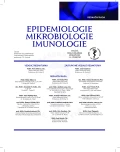-
Medical journals
- Career
Clonal characterisation of Streptococcus pneumoniae strains using MLST and MLVA – Can MLVA improve the characterisation?
Authors: J. Kozáková; Z. Okonji; M. Musílek
Authors‘ workplace: Oddělení bakteriálních vzdušných nákaz, Centrum epidemiologie a mikrobiologie, Státní zdravotní ústav, Praha
Published in: Epidemiol. Mikrobiol. Imunol. 69, 2020, č. 1, s. 20-28
Category: Original Papers
Overview
Aim: To determine clonal characteristics of Streptococcus pneumoniae (S. pneumoniae) strains causing invasive pneumococcal disease (IPD) in the Czech Republic (CR) in 2017. Clonal assignment of strains was performed in the National Reference Laboratory for Streptococcal Infections (NRL) by the routinely used method, multilocus sequence typing (MLST), and a newly introduced method, multiple-locus variable number tandem repeat analysis (MLVA).
Material and method: The study strains were 87 isolates of S. pneumoniae selected from those referred to the NRL within the IPD surveillance programme from all over the CR in 2017. The study set covers S. pneumoniae isolates of both pneumococcal 13-valent conjugate vaccine serotypes (1, 4, and 9V) and non-vaccine serotypes (8, 9N, and 22F) widely spread in the CR. The study methods were MLST, the standard method used worldwide for the characterisation of pneumococcal isolates based on sequencing of a set of gene regions, and MLVA, which allows to characterise isolates based on the number of tandem repeats in intergenic regions.
Results: MLST revealed and confirmed a high level of clonal homogeneity of S. pneumoniae isolates of serotypes 1, 9N, 9V, and 22F and a considerable genetic variability of serotype 4 and 8 isolates. There was a general correlation between the MLST and MLVA clonal complex assignments. In comparison with MLST, MLVA has superior clonal discriminatory power. Isolates with the newly determined MLVA profiles should be assigned to new MLVA types (MT). Nevertheless, the new web support of the MLVA scheme for S. pneumoniae is less relevant as it does not provide services comparable to those available from the web support for MLST characterisation.
Conclusions: MLST continues to be the standard method for clonal characterisation of S. pneumoniae isolates from IPD for the purposes of both national and international surveillance. MLST characteristics of isolates are helpful in the study of clonal variability conducted by both national and transnational public health protection authorities. MLVA is not routinely used but can serve as a complementary method for rapid identification of clonal relatedness between isolates, e.g. those from local outbreaks. It is more suitable for the detection of emergence and spread of a virulent clonal variant.
Keywords:
surveillance – Streptococcus pneumoniae – MLST – clonal characterisation – MLVA – serotype
Sources
1. Vyhláška č. 275/2010, příloha 21 Systém epidemiologické bdělosti invazivních pneumokokových onemocnění.
2. Vacková Z, Klímová M, Kozáková J. Nová metoda a schéma typizace Streptococcus pneumoniae. Epidemiol Mikrobiol Imunol, 2013;62(2):10–18.
3. Enright MC, Spratt BG. A multilocus sequence typing scheme for Streptococcus pneumoniae: identification of clones associated with serious invasive disease. Microbiology, 1998;144(11):3049–3060.
4. Kozáková J, Musílek M, Okonji Z. Charakterizace kmenů Streptococcus pneumoniae metodou MLVA (Multiple-Locus Variable number tandem repeat Analysis) v NRL pro streptokokové nákazy SZÚ. Zprávy CEM (SZÚ, Praha), 2018;27(11–12):284–286.
5. https//pubmlst.org/spneumoniae/
6. Martin B, Humbert O, Camara M, et al. A highly conserved repeated DNA element located in the chromosome of Streptococcus pneumoniae. Nucleic Acids Res, 1992;20(13):3479–3483.
7. Knutsen E, Johnsborg O, Quentin Y, et al. BOX elements modulate gene expression in Streptococcus pneumoniae: impact on the fine-tuning of competence development. J Bacteriol, 2006;188 : 8307–8312.
8. van Belkum A, Sluijter M, de Groot R, et al. Novel BOX repeat assay for high-resolution typing of Streptococcus pneumoniae strains. J Clin Microbiol, 1996;34(5):1176–1179.
9. Koeck J-L, Njanpop-Lafourcade B-M, Cade S, et al. Evaluation and selection of tandem repeat loci for Streptococcus pneumoniae MLVA strain typing. BMC Microbiol, 2005;5 : 66.
10. Elberse KEM, Nunes S, Sá-Leáo R, et al. Multiple-Locus Variable Number Tandem Repeat Analysis for Streptococcus pneumoniae: Comparison with PFGE and MLST. PLoS ONE, 2011;6(5):e19668.
11. https://mlva.net/
12. Francicso AP, Bugalho M, Ramirez M, Carrico JA. Global optimal eBURST analysis of multilocus typing data using a graphic matroid approach. BMC Bioinformatics, 2009;10 : 152.
13. Francisco AP, Vaz C, Monteiro PT, et al. PHYLOViZ: phylogenetic inference and data visualization for sequence based typing methods. BMC Bioinformatics, 2012;13 : 87.
Labels
Hygiene and epidemiology Medical virology Clinical microbiology
Article was published inEpidemiology, Microbiology, Immunology

2020 Issue 1-
All articles in this issue
- Biofilm-producing potential of urinary pathogens isolated from chronic and recurrent urinary tract infections and impact of biofilm on gentamicin and colistin in vitro efficacy
- Therapeutic potential of bacteriophages for staphylococcal infections and selected methods for in vitro susceptibility testing of staphylococci
- Clonal characterisation of Streptococcus pneumoniae strains using MLST and MLVA – Can MLVA improve the characterisation?
- The potential for use of non-thermal plasma in microbiology and medicine
- Biological agents of bioterrorism – preparedness is vital
- The first confirmed detection of Staphylococcus argenteus in the Czech Republic
- Vzpomínka na MUDr. Martinu Havlíčkovou, CSc.
- Zemřel doc. MUDr. Zdeněk Ježek, DrSc., Rytíř českého lékařského stavu
- Pre-exposure prophylaxis, a new approach for HIV prevention: experience from the HIV Center of the Military University Hospital Prague
- Epidemiology, Microbiology, Immunology
- Journal archive
- Current issue
- Online only
- About the journal
Most read in this issue- Therapeutic potential of bacteriophages for staphylococcal infections and selected methods for in vitro susceptibility testing of staphylococci
- Biological agents of bioterrorism – preparedness is vital
- The first confirmed detection of Staphylococcus argenteus in the Czech Republic
- Pre-exposure prophylaxis, a new approach for HIV prevention: experience from the HIV Center of the Military University Hospital Prague
Login#ADS_BOTTOM_SCRIPTS#Forgotten passwordEnter the email address that you registered with. We will send you instructions on how to set a new password.
- Career

